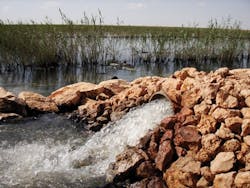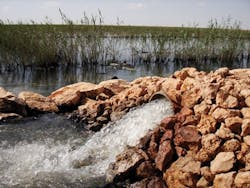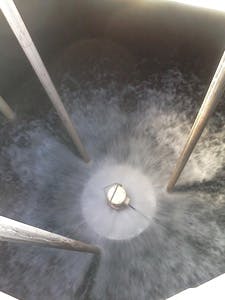Lining Project Restores Wastewater Treatment Clarifiers
By David Snider
When tasked with restoring 14 concrete clarifiers, important structures in the wastewater treatment process, the Clark County Water Reclamation District (CCWRD) faced several challenges such as airborne dust, hot and arid conditions, the implementation of a system mockup and an emphasis on in-field quality control.
The project's specifications, prepared by Black and Veatch, required the contractor to install a mock-up of the lining system prior to the final application. The ultimate goal of this step was to demonstrate the compatibility of the chosen lining system with the actual concrete comprising the structure. In compliance with this specification, Bryan Painting personnel prepared a random section of the concrete and applied the epoxy resurfacing material, a material designed to bring deteriorated concrete back to its original thickness prior to coating.
The next step was to perform an in-field adhesion test, known as "ASTM D7234 - 05 Standard Test Method for Pull-Off Adhesion Strength of Coatings on Concrete Using Portable Pull-Off Adhesion Testers," which determines the bond strength, (in pounds per square inch) of the resurfacing material in relation to the prepared concrete. In this case, the values obtained approached 500-lbs/in2 , meaning cohesive failure occurred within the concrete. In other words, the bond of the epoxy resurfacer was greater than the tensile strength of the concrete, which is the best result that can be obtained.
Following a successful mockup, the contractor was ready to proceed. Good surface preparation is essential for any protective coating application. In addition to removing all weak and chemically attacked concrete, the surface preparation procedure must provide a good "anchor profile" for application of the lining system.
The contractor on this project quickly realized that the amount of dust generated from the abrasive blasting was not compatible with coating. To overcome this challenge the project team employed a combination of abrasive and water, which dramatically reduced dusting and provided the required surface profile.
The project included an open-top structure with high temperatures and swirling winds, making the use of cement-based resurfacing material problematic. Under these conditions cementitious repair material is prone to cracking and delaminating. The project team determined that the solution was to use an epoxy-based repair material, one which didn't require a pre-dampened substrate or post-curing with water. The result was a strong, firmly-adhered repair material, which restored the structure to its "pre-corrosion" dimension. The application of the protective lining material could then proceed.
Epoxy-based coatings and linings have been used in wastewater collection and treatment infrastructure for more than 40 years. During this period, manufacturers have modified these products to enhance their performance in wastewater-specific applications. Protective coatings must possess several features, including the ability to bond to damp surfaces and to cure properly in high humidity environments. They must also have the required physical properties including good abrasion-resistance, high bond-strength and low permeability. A low permeability material will protect a concrete or steel structure from chemical attack for the long-term.
For this project, the team chose Sauereisen SewerGard™ protective coatings and linings, which maintain the requisite properties and are back by 25-years of history in the municipal wastewater market. This product was chosen after members of CCWRD visited a lift-station in nearby Henderson, NV, where the SewerGard lining had been installed in 1992. The lining was still in excellent condition. This was proof that the lining system works in the southwestern U.S. where some of the most corrosive wastewater environments exist.
The installing contractor, Bryan Painting, successfully lined all 14 structures over a period of two years. The lining was applied to a thickness of 125-mils and, after curing, was tested to ensure there were no pinholes. In addition, the project underwent "High-Voltage Spark Testing" to identify pinholes as well as adhesion testing to confirm that the lining was firmly adhered to the concrete substrate. This type of in-field quality control continues to gain in popularity as owners want more assurance that the chosen materials are installed correctly. Often times a third party inspector is employed to oversee the installation.
About the Author: David Snider, Western Regional Manager for Sauereisen, Inc. of Pittsburgh, PA has over 30- years of experience in the field of corrosion-resistant materials of construction. He has held positions in R&D, Technical Service and Sales.
More WaterWorld Current Issue Articles
More WaterWorld Archives Issue Articles


